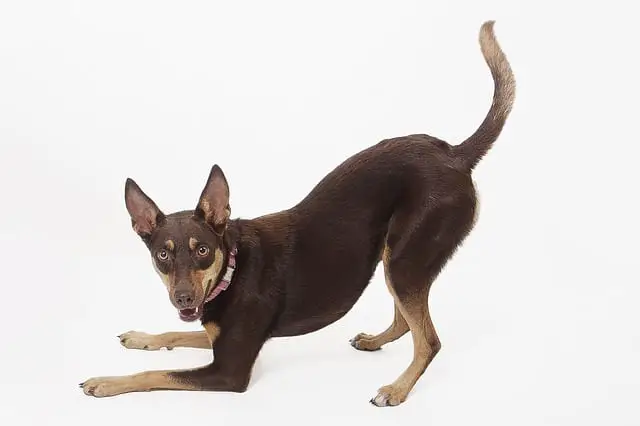
The Australian Kelpie dog breed is characterized by its muscular build and inexhaustible energy. It is an intelligent, industrious animal, always alert, passionate about its master and easy to train. Its demeanor is that of a cheerful, sweet, affectionate dog, devoted to work. At Petlifey, we explain the character and characteristics of the Australian Kelpie.
Character of the Australian Kelpie
The Australian Kelpie’s temperament is intelligent and industrious, always on the alert. It also has a docile disposition and an almost inexhaustible energy.
It displays a demeanor of great loyalty and devotion to work, and has a natural instinct for working with sheep. The kelpie possesses inexhaustible energy and loyalty to its master; it is an animal that gives everything, but also demands to be reciprocated. In this respect it is similar to the Australian Shepherd breed.
With proper training it can become a good companion dog, cheerful and easy going, always ready to play, and a valuable friend to children, whom it adores.
Raised in the wild and always dedicated to working with livestock, the Australian kelpie is a very intelligent, agile, active, affectionate and, above all, hardworking dog.
Always attentive to the order of its master, it shows great loyalty. There are those who claim that they are capable of carrying out their duties even when they are sick or injured.
In addition to herding, due to its adaptable and versatile nature, and its strong work habits, this breed has become essential in tasks such as detecting explosives and drugs.
As its size is not excessively large, it has an advantage over other larger utility dogs than it, as it is easier to transport and maintain. This circumstance, in actions such as the search for the disappeared in disaster areas, may be a determining factor in continuing to consolidate its growing popularity.
- Energy: Very high level. You are very active and need to burn energy through hard exercise.
- Temperament: Balanced and independent, it needs to be socialized so that it can relate well with people. Responds very well to training.
- Adaptability: Medium / low. You cannot live in small spaces or in an urban environment. You need freedom.
- Sociability: Medium / high. It enjoys the people it lives with, but is suspicious of strangers.
- Health: Good. It does not have a tendency to suffer from serious hereditary diseases.
- Longevity: Medium. You can live 10 to 12 years in good health.
- Utility: Very versatile. It learns with ease, and can work as a shepherd dog, search and rescue dog, for explosives and drug detection, or as a guard dog.
- Utilization: Grazing and guarding.
Can you live in an apartment?
This breed does not tolerate life in the city very well, in the closed space of an apartment. The same happens with “his cousin” the Australian herd.
For its proper physical and mental development it needs open landscapes, fresh air and continuous exercise, without which it may end up presenting behavioural problems.
For this reason, it is one of the few breeds of shepherd dog that still maintains its presence in its original field of work.
Indeed, the vast majority of active kelpie specimens live in Australia; However, the breed has already begun a timid expansion, and is currently used in the United States for herding cows, pigs, horses and even reindeer.
Characteristics of the Australian Kelpie
The general appearance of the Australian Kelpie is that of an active and useful dog, as it is endowed with great muscular conditions combined with highly elastic limbs that allow it to work tirelessly. Its appearance does not reflect weakness, but strength.
The body is that of a strong, agile, elastic dog with an almost square body structure, since the length of the body is only slightly greater than the height at the withers, which is about 48 cm in males and about 48 cm in females.
Its head is well proportioned to the size of the dog, resembling that of a fox. The skull is somewhat rounded, wide between the ears and with a marked stop. The muzzle is well defined.
It has almond-shaped and medium-sized eyes, giving the dog an intelligent and alert expression. They are brown in color, but blue specimens are usually lighter.
Their ears are widely separated from each other, they are medium in size and have hair on the inside. They slope outward and form a slight curve at the outer edge.
It has strong, round feet, with the toes close together, well arched and ending in short, strong nails. The foot pads are thick.
Its tail is quite long and is covered with abundant fur. At rest, the dog carries it dangling and slightly arched, but picks it up when alert.
Fur
The hair is double, with an undercoat of short and dense hair, and a tight outer layer, with a hard and stretched texture, with the hairs well glued, so that the coat is a good protector against the rain. On the neck it forms a necklace.
On the hind legs the coat is longer, and on the thigh it forms a slight “trouser”. Rather, it is short on the head, front of the limbs, and on the feet.
Colour
The Australian Kelpie has a wide range of colors and tones. There are several possible colorations, such as black, black and tan, red, red and tan, tawny, chocolate, and smoke.
Movement
With a perfect gait, the movement is loose and effortless, and the dog is able to turn suddenly without slowing down.
As you accelerate during your jog, your feet tend to come closer when they come to rest on the ground; but when the dog is at rest, all four feet are in the correct perpendicular position.
Australian Kelpie breed standard
- Origin: Australia.
- Other names: Australian Kelpie / Kelpie australien / Australischer Kelpie.
- Size: Medium / Large
- Height at the withers: 46-51 cm (Males) and 43-48 cm (Females).
- Weight: 15-20 kg (Males) and 11-16 kg (Females).
- Head: It is in proportion to the size of the dog. Together, the shape and contour of the head give it a fox-like expression, which is tempered by the almond-shaped eyes.
- Skull: Slightly rounded and broad between the ears; Seen from the side, the forehead descends in a straight line towards the naso-frontal depression.
- Nose-frontal depression (stop): It is marked.
- Muzzle: Clearly molded and defined, it is somewhat shorter than the skull. Nose: Its color harmonizes with that of the coat.
- Jaws: The jaws are strong, with healthy and regularly aligned teeth, and the bite is perfect and complete in scissors.
- Eyes: They are almond-shaped, of medium size, with a well-defined angle, and their expression is intelligent and alert. The brown color predominates, in harmony with the color of the coat, although blue-coated dogs have lighter eyes.
- Ears: They are erect and end in a fine point; the membrane of the ear is thin, but strong at the base. Set well apart, they slope outwards and form a slight curve at the outer edge. Their size is medium, and they are well provided with hair on the inside.
- Neck: Of moderate length, it is strong, slightly arched and has no dewlap, but it does have an abundant collar.
- Body: It is robust and strong, with a firm and uniform top line.
- Back: Strong and very muscular loin, with a long and sloping rump. Chest: It is deeper than broad, with the ribs well fitted.
- Tail: Provided with abundant hair in the form of a brush, it reaches approximately to the hock. At rest, it hangs somewhat arched, but in movement or alert the dog lifts it, without exceeding the insertion point.
- Forelimbs: Muscled, strong but not thick bones are straight and parallel seen from the front.
- Shoulders: Well defined, muscular and sloping, shoulder blades close together in the region of the withers.
- Forearms and arms: The former are strong and well muscled. The upper arm is at right angles to the shoulder blade.
- HINDQUARTERS: Broad and strong, viewed from behind, from the hocks to the feet, are straight and parallel, m together or too far apart.
- Legs: They are strong and well muscled.
- Knees: Well angulated.
- Hocks: They appear placed quite close to the ground.
- Feet: Round and strong, with thick pads. The fingers are close together and well arched, and the nails are short and strong.
- Skin: The skin is well adjusted, without forming folds.
- FCI Classification: FCI No. 293. Group 1 – Sheepdogs and Cattle Dogs (except Swiss Cattle Dogs). Section 1 – Sheepdogs.
Education and training of the Australian Kelpie
In order to educate an Asutralian Kelpie, it is essential to start from a puppy. Due to its function, this dog needs to do a great deal of exercise on a daily basis. A good way to channel your energy is by playing sports.
In fact, this animal has ended up becoming an excellent companion for jogging, since to its undeniable qualities must also be added a natural aptitude for sport, so that it is increasingly common to see specimens of the breed in the different sports competitions with dogs.
It stands out especially in agility, an activity for which it has abilities similar to those of other breeds with which it is related, such as the collies or the Australian sheepdog: it is fast, energetic, intelligent and has an excellent memory, all of which are ideal qualities. for the aforementioned sport.
In addition, with respect to the almost unbeatable border collies, this one has in its favour a more stable character and a less tendency to disperse, so with less training, it is able to execute the exercises with great speed, cleanliness and precision.
Exercise is, therefore, the first necessity that must be attended to to guarantee good physical and mental health to the Australian kelpie.
Australian Kelpie health and care
In this breed, which is eminently healthy and not prone to disease, food needs are closely linked to its morphology and character.
An adult specimen weighs between 15 and 20 kg, but is of robust constitution, like all shepherd dogs, and many of the health problems that could occur throughout its life are derived from the lack of daily and constant exercise, which is the only thing that allows you to stay in top physical shape.
Australian Kelpie diet
Being a lively dog, with an explosive temperament and a hard worker, it needs a diet that is very rich in calories, with a great supply of proteins that guarantee the maintenance of its muscular power.
In the same way, you need a good base of carbohydrates that provide you with fuel to work for long periods of time and a sufficient fat intake to keep your skin, hair and other vital organs in good condition.
Hygiene and maintenance of the Australian Kelpie

Australian kelpie hair is very easy to maintain and not demanding at all, as it simply needs a good brushing from time to time.
In fact, it is enough to use a metal card, a tool with which it is possible to stimulate the epidermis and eliminate possible dead hair at the same time.
Shorter hair areas, such as the face, legs and ears, can be worked with a horsehair brush or a leather cloth.
As for the bathroom, it is enough to do it when the animal is really dirty and for this it is not necessary to use any specific product.
As with almost all breeds, the hygienic routine should always be completed by checking the condition of the nails, eyes, mouth and ears.
Although it is still not very well known outside of Australia, this animal is gaining followers very quickly, as its effectiveness at work and its kind and faithful character are making it score points among dog fans.
